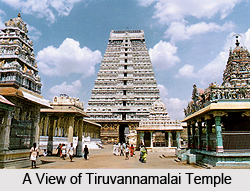 Tiruvannamalai Temple is one of the largest temples in India. It is nestled at the base of Annamalai hills in the town of Thiruvannamalai in the Indian state of Tamil Nadu. This temple is dedicated to Lord Shiva who is worshipped here in the form of fire. Here, Shiva is known by devotees as Annamalayar or Arunachaleswarar. The temple is significant to the Hindu sect of Saivism.
Tiruvannamalai Temple is one of the largest temples in India. It is nestled at the base of Annamalai hills in the town of Thiruvannamalai in the Indian state of Tamil Nadu. This temple is dedicated to Lord Shiva who is worshipped here in the form of fire. Here, Shiva is known by devotees as Annamalayar or Arunachaleswarar. The temple is significant to the Hindu sect of Saivism.
History of Tiruvannamalai Temple
The history of this temple dates back to thousand years. According to the details available from archeological sculptures, this temple on the foot hill of Annamalai hill came to be built around 750 A.D. However, there are different opinions about the exact date of the construction of the temple. It finds mention in Thevaram and Thiruvasagam, both great works in Tamil.
Mythological Significance of Tiruvannamalai Temple
This shrine is the home of Annamalayaar or Arunachaleswarar (Shiva worshipped as a Shiva Lingam) and Unnamulaiyaal (Apitakuchambaal - Parvati). The term Annamalayar is derived from the name of the hills Annamalai that means an inaccessible mountain. The temple is a Pancha Bhoota Stalams (one of the five grand temples associated with the five basic elements) - associated with the element Fire, the other four being Tiruvanaikkaval (Water), Chidambaram (Space), Kanchipuram (Earth) and Sri Kalahasti (Wind) respectively. Shiva manifested himself here as a massive column of fire, whose crown and feet, Bhramma and Vishnu attempted in vain to reach. A celebration of this manifestation is seen today in the age old traditions observed in the Shivaratri and the Kartikai Deepam Utsavams held here.
Architecture of Tiruvannamalai Temple
It is one of the largest temples in India. Granite and other precious stones have been used to construct the temple. It has four gateway towers, the gopuram, on its four sides. It is situated at the bottom of the Annamalai hills, and faces east. The temple has a total of five precincts, each of which holds a huge Nandi. Presently, it is maintained and administered by the Hindu Religious and Charitable Endowments Department of the Government of Tamil Nadu.
Medicinal Significance of Tiruvannamalai Temple
It has many meditation and research centers devoted to siddha medicine. It is believed that many notable siddha yogis have lived here to offer their services to cure many ailments for all the sick people who came seeking for treatment. Going girivalam during every full moon day of a month or during the annual Tiruvannamalai deepam day at Tiruvannamalai is considered holy by many devotees.
Festivals of Tiruvannamalai Temple
The temple celebrates dozens of festivals throughout the year. Some of the prominent festivals are Brahmotsavam and Tiruvoodal. During these festivals, several rituals are performed and various offerings are made to the God and Goddess.





















